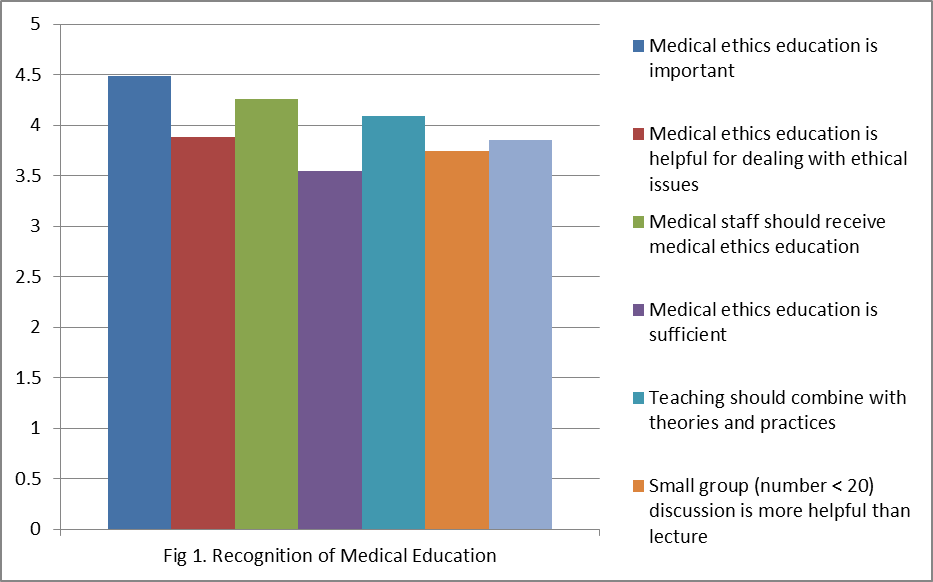| ePOSTER | ||
| Theme: 4BB Teaching tools |

|
| Abstract Title | ||
| Recognition and Assessment of Medical Students Satisfaction Receiving Medical Ethics Using Multimedia Case Teaching Video | ||

|
Authors: |
Pei-Wei Wang Li-Lin Kuo Oscar k Lee Ran-Chou Chen |
Institutions: | Taipei City Hospital - Taiwan |
In the Asia-Pacific region, the vast majority of medical schools have provided medical ethics education since 1999. Providing medical students with ethics education earlier promotes the development of a sensitivity and depth of thinking about ethics issues. To promote quality in local medical education similar to the advanced countries, the Ministry of Education entrusted the National Health Research Institutes to establish the Taiwan Medical Accreditation Council (TMAC). TMAC requires teaching hospitals to provide medical ethics education and includes compliance in the accreditation process. Studies about medical ethics education for post-graduates including residents, attending physicians and other medical staff in the hospital, are limited as compared to studies with undergraduate students. Studies of medical ethics related education in regional hospitals are fewer in Taiwan.
The objective of this research is to explore the medical students’ recognition for medical ethics education and their satisfaction receiving medical ethics education by using “multimedia case teaching video” in a regional teaching hospital in Taiwan.
Based on reference literature, multiple expert seminars and the ethics cases database of Taipei City Hospital, the center for faculty development developed a series of multimedia case teaching video for the medical ethics education for hospital staff. Participants viewed a multimedia case teaching video to discuss and analyze the real case after the end of the movie. Anonymous, self-administered questionnaires and satisfaction survey were collected after obtaining their consents. The questionnaire is to survey the recognition of medical ethics education. Demographic data such as sex and age were also completed. The satisfaction items about the overall course, content, teacher’s performance and personal benefits (two questions) were included. TThere were five satisfaction (agreement) ratings including very unsatisfied (disagreed), unsatisfied (disagreed), fair, satisfied (agreed) and very satisfied (agreed). This study was conducted from Dec 2013 to Apr 2014.
A total of 35 medical students receiving intern training at our hospital participated this study. There were 25 males (71.4%) and 10 females (28.6%) who participated. Most (88.6%) were 20-30 years old and 4 (11.4%) were 30-35 years old. 34(97.1%) had a agreement that medical ethics education is important, and 24 (70.4%) agreed helpful for dealing ethical issues or ethical dilemmas. 31 (91.2%) have taken ethical course at school, and 24 (70.6%) took law courses at school. 30 (83.3%) indicated they were satisfied with the course. 80.6% responded that this course was very helpful and would recommend to their peers. However, most participants (83.9%) revealed that combining multimedia case teaching video with PBL or case study is the best method to teach medical ethics.

Many methods for teaching medical ethics has been described. Lectures, patient consultations, case discussions, clinical round teaching, supervision, small groups, movie-triggered discussions, issue-driven discussions, problem based learning, simulations, standardized patients and role playing are included. However, studies about the proper method are limited. It is also difficult to assess learning outcomes.
Using medical drama as a method to teach medical ethics has been advocated recently. It could enhance emotional engagement, cognitive development, and moral imagination which allow for a more ethically sensitive student in training. Our previous study has demonstrated that use of a video with actual case examples is an effective method and can improve the learning outcome of post-graduate practitioners. In this study, we also showed that medical students were highly satisfied with this method. For teaching medical ethics, multimedia teaching videos combining with PBL or case study is warranted to use.
Using a multimedia case teaching video is a valuable method for medical ethics education
1. Miyasaka M: An international survey of medical ethics curricula in Asia. J Med Ethics 1999; 25:514-21.
2. Wang P.W., Chen R.C., Chang S.Y. Assessment of hospital staff satisfaction and training outcome receiving medical ethics education on disclosure using multimedia case teaching video. J Med Education 2012;16(2): 63-69.
3.Singer PA, McKneally MF: Bioethics at the bedside: 25. Teaching bioethics in the clinical setting. CMAJ 2001;164:1163-7.
4. Dingle A.D., Stuber M.L. Ethics Education. Child Adolesc Psychiatric Clin N Am 2008;17:187–207
5. Thalia Arawi. Using medical drama to teach biomedical ethics to medical students. medical teacher 2010; 32: e205–e210.
 Send Email
Send Email